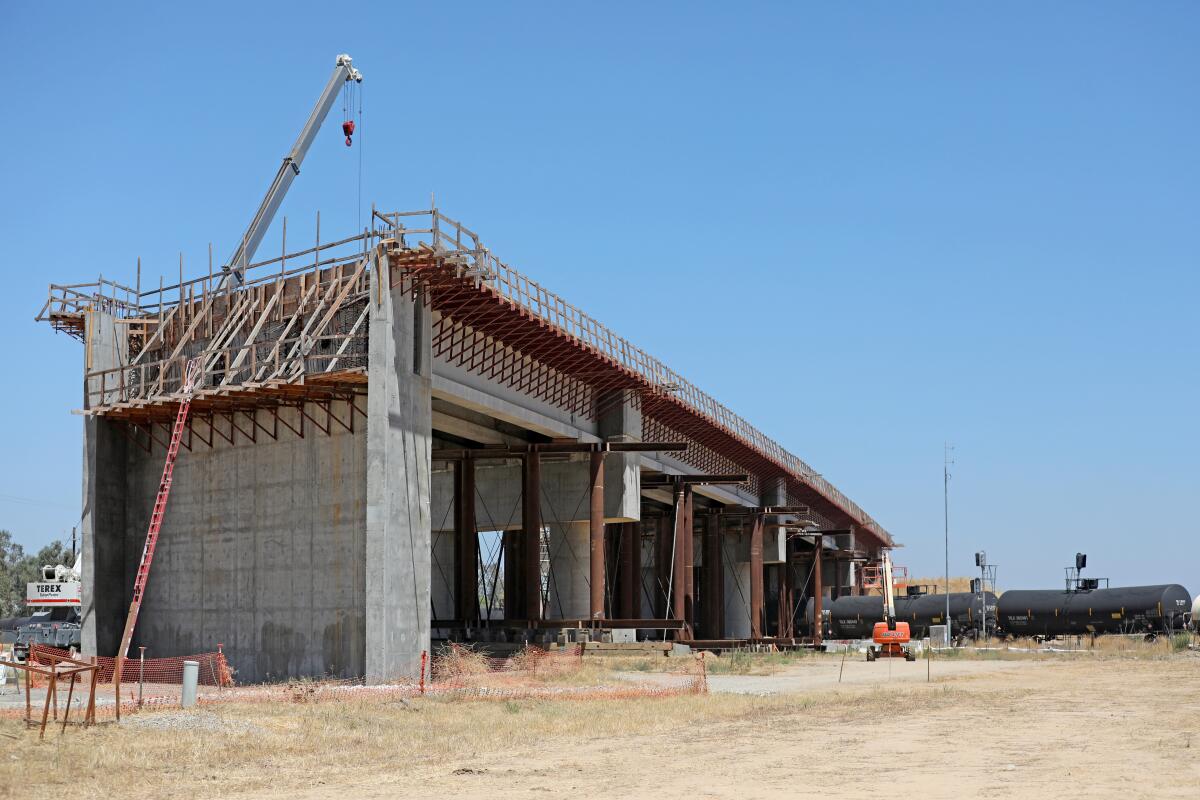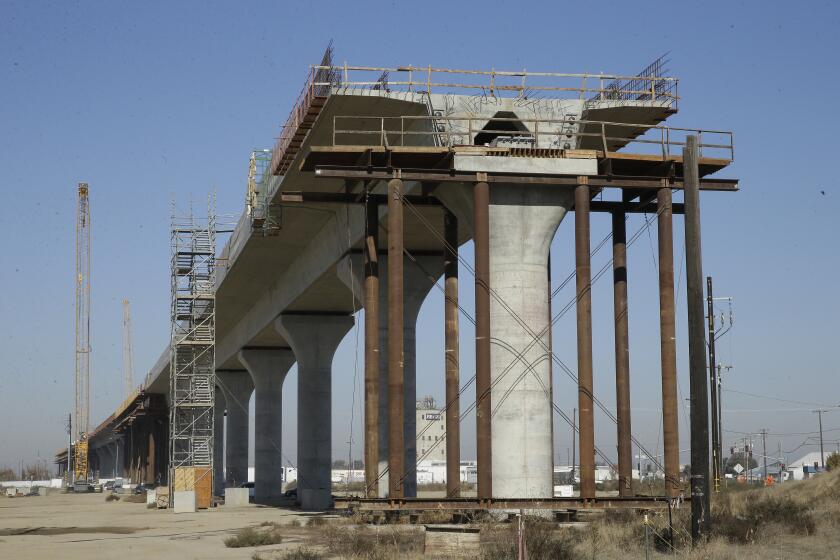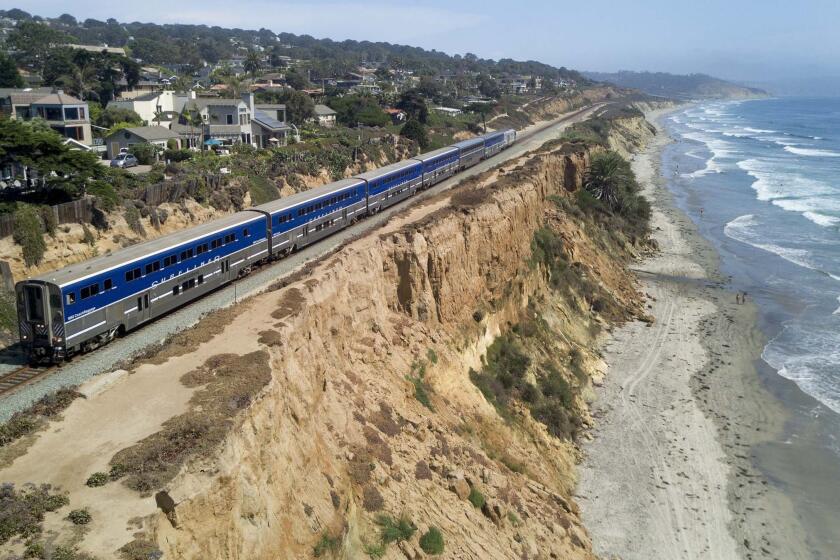Biden infrastructure funds will help state bullet train, but not as much as boosters hoped

- Share via
The infrastructure bill that President Biden plans to sign Monday contains a historic amount of new funding for passenger rail service and aims to remake its role in American transportation, but any boost for the nation’s bullet train ambitions will be limited at best.
Exactly how much money will reach various rail projects — including the financially challenged California bullet train — is still an unknown and will depend on how the complex law is administered and developed into grant programs.
Hopes for a $100-billion national high-speed rail program, a goal backed by former secretaries of transportation, labor unions, major engineering firms and rail advocates, were dashed by the bipartisan infrastructure bill. Most of the money for rail systems will go to Amtrak’s service on the East Coast, various long-distance Amtrak routes and freight rail systems.
The follow-up social and climate legislation, the so-called Build Back Better bill, contains a $10-billion clause for high-speed rail projects across the country, as well.
The clause, sponsored by high-speed rail advocate Rep. Seth Moulton (D-Mass.), has speed requirements that could be met only by California’s ongoing project, as well as proposed projects in Texas and a Cucamonga-to-Las Vegas train. Whether the funding stays in the legislation and whether the entire bill will pass the Senate is unclear.
If that $10 billion is spread out, the benefit to the California High-Speed Rail Authority will be modest. One consultant, speaking on background, estimated that the California bullet train might get about $4 billion out of both pieces of legislation.
It would clearly help the project, which is experiencing sharp cost increases in Central Valley construction, but it is a small fraction of what is needed to connect future tracks through mountain tunnels to Southern California or the Bay Area.
In a September board meeting, rail authority Chief Executive Brian Kelly outlined that the infrastructure bill contained about $21 billion of new funding on top of existing appropriations that the authority could pursue. About half of the $1.2-trillion infrastructure bill comes from existing funding commitments.
At a critical time, the California High-Speed Rail Authority is unsure about funding from the Legislature and President Biden’s infrastructure plan.
Why California came up with so little and the East Coast was rewarded with the largest rail investment in half a century is complex. Lobbyists say the Northeast states came together with a unified proposal, backed by multiple state delegations. It was boosted by a president who is an Amtrak fan.
By contrast, the schedule and cost problems of the California bullet train may have hurt its chances. It long ago lost bipartisan support within the state, and House Minority Leader Rep. Kevin McCarthy (R-Bakersfield) opposed the project. The infighting hurt the state’s chances of getting more federal money.
Although the dedicated $10 billion in the social and climate change bill is greater than what the Obama administration’s stimulus bill provided a decade ago, it is not a game-changer for high-speed rail in America.
“It is a typical federal approach,” said Joseph Schofer, a Northwestern University civil engineer and creator of the podcast “The Infrastructure Show.” “You take an ounce of peanut butter and spread it over five loafs of bread and you say everybody got something.”
Schofer said the infrastructure bill is important to redress decades of neglect, but a serious problem remains unanswered: How did the nation get into such serious disrepair and how do we avoid it in the future? “The bill is a once and done,” he added.
Proponents of the rail spending see hope.
“We celebrate each incremental step we take,” said John Roberts Smith, chairman of the advocacy group Transportation for America and former Amtrak chairman.
Deputy Transportation Secretary Polly Trottenberg, a former New York City transportation commissioner, earlier this week called the bill a “remarkable achievement” and described some of its far-ranging benefits for transit systems, electric vehicles, airports and ports, among much else. But a fact sheet put out by the department included few details about spending that will be spread out over the next decade.
A lengthy passage of the bill, Section 22307, indicates that much of the funding will be allocated on a competitive basis, meaning how it ultimately gets spent is unpredictable, according to Schofer.
In a statement to The Times, Amtrak officials said that $22 billion of $66 billion in infrastructure funds for rail will be allocated to its capital projects and fleet acquisitions across its system.
It would include such projects as the Hudson Tunnel and East River tunnels in New York, a Connecticut River bridge, and station projects in Washington and Boston.
The other $44 billion would be provided to the Federal Railroad Administration for grants to Amtrak, state systems and “other rail projects.”
Outside of the Northeast, the full package would provide new passenger equipment for long-distance trains and “state supported” trains. It would also bring Amtrak-served stations into compliance with disability laws.
Regional transportation agencies, political consultants and lobbyists are still trying to unpack the details of the Infrastructure Investment and Jobs Act — a document that contains 414,000 words of technical legalese, often clauses that reform prior laws.
Amtrak is the biggest winner, likely to get the vast majority of the $66 billion to build new tunnels and upgrade track on the Northeast Corridor from Boston to Washington. A smaller portion would be used to “support and upgrade corridors all across the county,” said Trottenberg, but the amount appears undermined.
Smith, the Transportation for American chairman, said he believes there exists billions of additional dollars for rail spread throughout the legislation, an assertion that U.S. transportation officials could not confirm.
The Biden administration is said to be mulling a $3-trillion infrastructure plan it may soon unveil. California transportation agencies are onboard.
“The number is the biggest we have ever seen invested in passenger rail,” Smith said. “More importantly, they have transformed the mission of Amtrak to meet intercity passenger rail needs of the U.S.”
The money would rebuild at least two key tunnels that are bottlenecks, one in New York City and another in Baltimore. It would purchase new trains and fix decrepit track.
The law will put new emphasis on long-distance Amtrak routes, which have been sharply cut back over the years to stem financial losses. It will put in place a new board of directors, require live ticket agents in stations and even improve meal service.
The corridor is where the Acela, Amtrak’s fastest train, operates. It hits a top speed of 150 mph, but only over a limited section.
The multibillion investments in the route will cut the trip time from Boston to Washington from six hours to possibly five, according to Transportation Department documents. Faster, to be sure, but not fast enough to meet international standards for a bullet train.
More to Read
Sign up for Essential California
The most important California stories and recommendations in your inbox every morning.
You may occasionally receive promotional content from the Los Angeles Times.













